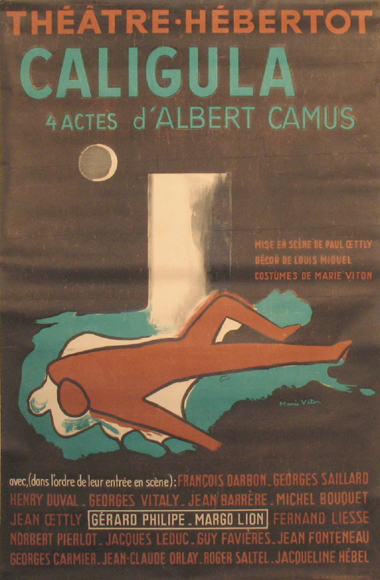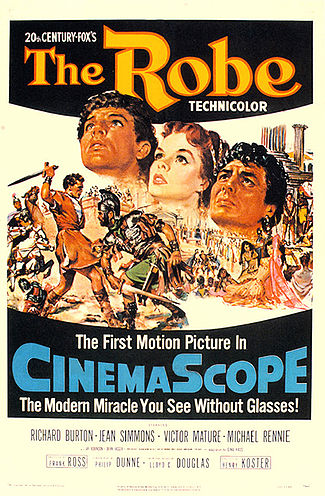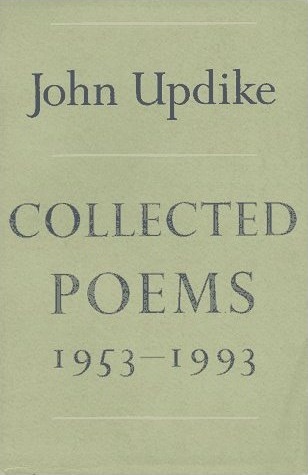• 1647.
Caligula fait deposer les cendres de sa mere et de son frere dans le sepulchre de ses aieux
Caligola delirante
an opera by Giovanni Maria Pagliardi,
with a libretto by Domenico Gisberti
According to
Electronic Library the original title was La pazzia in trono ovvero Caligola delirante.
That same web page also states that
the revival in 1674 (retitled Il Caligola: dramma per musica) at the nuovo Teatro di Tor di Nona had some differences:
“Three acts. Gisberti’s text, with noticeable differences from the version of Venice,
1672. For instance, I, 2 now begins, ‘O Diquanto il Sol vede,’ instead of ‘Su ! mia
figlia corraggio’; I, 6, ‘Nesbo di regal ceppo,’ has been dropped and I, 7, ‘De la
vaga Teosena,’ has become I, 6, etc., etc. Schatz 7586.”
The music score is available on microfilm at several libraries.
An original music score seems to be held at the Nazionale Marciana.
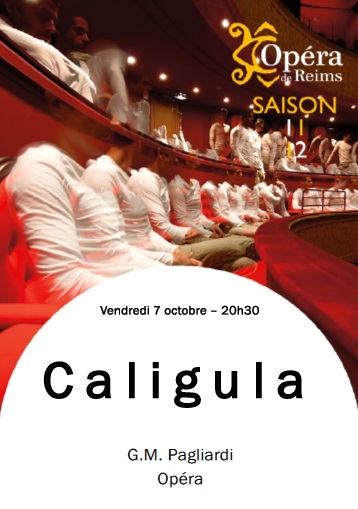
Currently being revived as a marionette show.
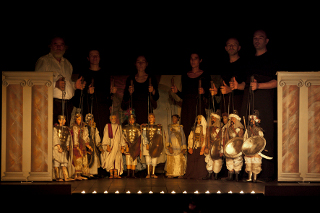
Reviews

Opens at L’Apostrophe — Théâtre des Louvrais, 4 October 2012.
An original music score seems to be held at the Nazionale Marciana.

Currently being revived as a marionette show.

Reviews

Opens at L’Apostrophe — Théâtre des Louvrais, 4 October 2012.
https://www.youtube.com/watch?v=Rn6fgWjpdNA
• Probably the middle of March 1698 at the (second) Theatre Royal (Drury Lane), London.
Caligula: A Tragedy
by John Crowne
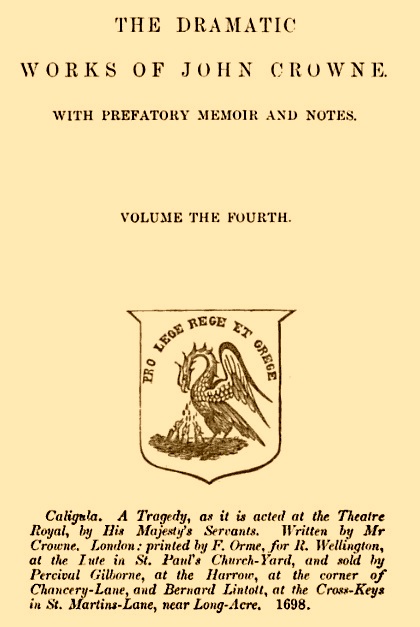
An original acting copy seems to have survived at least to 1999 when UMI scanned it,
and a digital copy can be found at the Huntington Library.
And now, thanks to Project Gutenberg:
A SONG made for the Entertainment of her Royal Highness.
Set by Mr. LEVERIDGE.
Sung by Mrs. LINDSEY in CALIGULA.
Listen to a synthesized MIDI file.

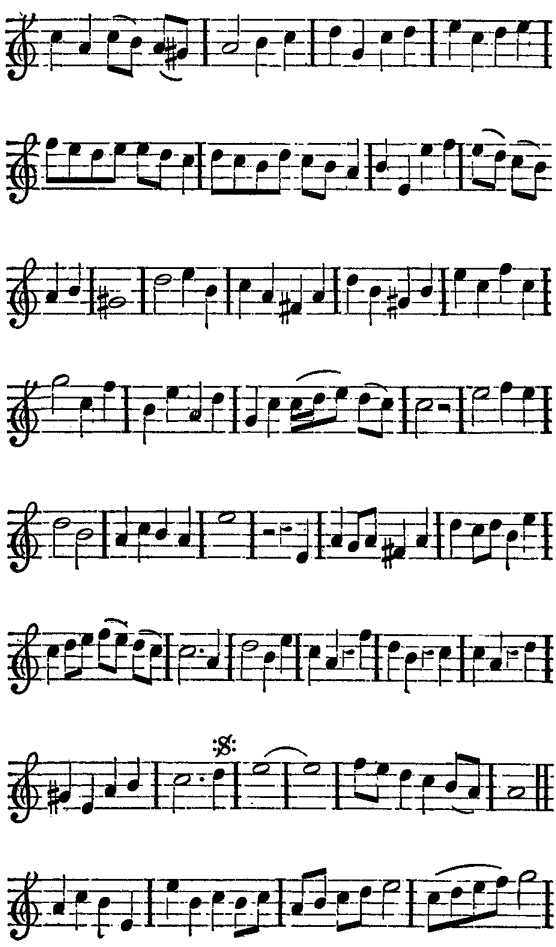
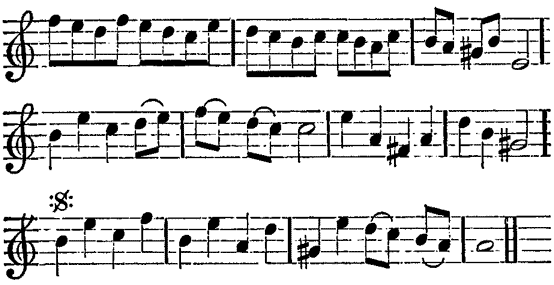
Set by Mr. LEVERIDGE.
Sung by Mrs. LINDSEY in CALIGULA.
Listen to a synthesized MIDI file.



|
Tho’ over all Mankind, besides my conquering Beauty, Conquering beauty, my conquering beauty Reigns; My conquering Beauty Reigns; From him I love, from him I love when I meet disdain, A killing damp, a killing damp comes o’er my Pride: I’m fair and young, I’m fair and young, I’m fair and young in vain: I’m fair and young, I’m fair and young, I’m fair and young in vain; No, no, no, let him wander where he will, Let him wander, let him wander, Let him wander, let him wander where he will, I shall have Youth and Beauty, Youth and Beauty, Youth and Beauty, I shall have Youth and Beauty, Youth and Beauty still; I shall have Beauty that can charm a Jove, Can Charm a Jove, and no fault, No, no, no, no, no, no, no, no, no, no fault, no, no, no fault, But constant Love: From my Arms then let him fly, fly, fly, From my Arms then let him fly; Shall I languish, pine, and dye? No, no, no, no, no, no, no, no, no, no, no not I. |
Another song, “Beneath the Covert of a Grove,” by Daniel Purcell, is available at the
Corporation of London Libraries.
• Sometime in the 1600s.
Cæsonia, Wife of Caligula
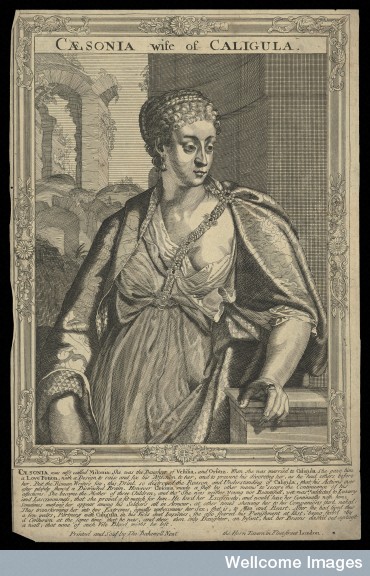
Wellcome Images, line engraving, after Ægedius Sadeler, after Titian.
Wellcome Library reference no.: Iconographic Collection 665121i.
Cajus Caligula: Oper in Drei Akten
(Oper 21,03)
(Oper 21,03)
music by Georg Philipp Telemann
libretto by Daniel Gisberti
An opera in three acts.
The libretto was by a “Daniel Gisberti,”
which sounds suspiciously similar to the Domenico Gisberti who wrote the libretto for Pagliardi’s opera some years earlier.
Yet it does seem to be a different person and a different libretto.
The libretto is held at the
Thüringer Universitäts- und Landesbibliothek in Jena and at the
Universitäts- und Landesbibliothek Sachsen-Anhalt / Zentrale in Halle/Saale.
There is probably a third copy at the
Universitätsbibliothek Greifswald but the listing is confusing.
The music score is considered lost.
Germanicus: Oper in Drei Akten
music by Georg Philipp Telemann
libretto by Christine Dorothea Lachs
An opera in three acts.
Written in 1704 and revised in 1710, but not performed until 2010. Only 40 arias survive.
For the 2010 performance and recording, arias and passages from other works, those by Telemann as well as other composers,
were interpolated to fill the gaps.
Such a practice was common at the time
and may be considered authentic now.
| Caligula | Friedrich Praetorius, soprano |
| Agrippina | Elisabeth Scholl, soprano |
| Claudia | Olivia Stahn, soprano |
| Florus/Lucius | Matthias Rexroth, alto |
| Segestes | Albrecht Sack, tenor |
| Arminius | Tobias Berndt, bass |
| Germanicus | Henryk Böhm, bass |
| speaker | Dieter Bellmann |
• 1752.
Cajo Caligola
Volume V of “Drammi eroici” (Belluno: Simòn Tissi, 1752).
This is available online at Nazionale Braidense.
Was this ever performed?
• 1780
Le Cheval de Caligula
Bordeaux, Philip-pot, 1780.
Reprinted as
Honni soit qui mal y pense, ou Le cheval de Caligula fait consul de Rome,
tragédie burlesque, parodie de différentes tragédies, en un acte, et en vers
attribuée à Mayeur de Saint-Paul (Bordeaux: Philippot, Marchands de brochures, 1782), 31 pages.
This was a burlesque, apparently, of
François Marie Mayeur de Saint-Paul ,
and it’s available at the
University of California at Berkeley.
Eloge historique du cheval de Caligula Consul Romaine
traduit du turc-arabe par Fanor
avec plusieurs chansonnettes toutes nouvelles du même auteur
traduit du turc-arabe par Fanor
avec plusieurs chansonnettes toutes nouvelles du même auteur
by Stiepan Zannovich (Stefan Zanović)
London: 1781, 40 sheets.
A book of chansonnettes, mostly in Italian, available at Stanford University.
Also available at
Herzogin Anna Amalia Bibliothek / Klassik Stiftung Weimar.
• 1826.
Caïus Caligula, Tragédie en 3 actes
by Camille Rouzé
• 1832.
Caligula, Tragédie historique en un petit acte et en grand vers(I)
by Nicolas Brazier and
Théophile Marion Dumersan
• 1833.
Caïus Caligula, drame en cinq actes
by Charles Thomas François D’Outrepont
• 26 December 1837, at the Théâtre Française.
Caligula, tragédie en cinq actes et en verse précédée d’un prologue
by Alexandre Dumas
 A costume designed by Eugene Giraud for the première production. |
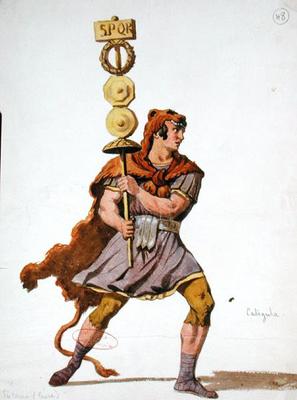 Another costume designed by Eugene Giraud for the première production. |

Spanish translation.
A German translation by Eduard Jerrmann survives at the Bibliothèque nationale et universitaire in Strassbourg and at the Staatsbibliothek zu Berlin — Preussischer Kulturbesitz.

Online English adaptation by Frank J. Morlock.
See also Revue Canadienne.
• 1838.
Caligula, pot-pourri, par Romain Duclacoir, citoyen gaulois de Pontoise
by Jules Lantin
Paris: Imp. de Stahl, 47 pages. A burlesque of Dumas’s play.
It is at the
Bibliothèque Nationale de France.
A unique English typescript translation is at the
University of Manchester Library, Main Library.
If you copy these for me, you’ll get a prize.
• 1838.
Caligula, un tragédie
by Louis-Aimé Martin
42 pages. Survives at the
Bibliothèque Interuniversitaire Sainte-Geneviève in Paris, 5º arrondissement.
If you copy this for me, you’ll get a prize.
• 1838.
Messaline à l’auteur de Caligula
by Anonymous
Paris: Barba, 1838. A poem. A copy is held at the
Bibliothèque nationale de France.
If you copy this for me, you’ll get a prize.
• 1838.
Tibère à Caprée,
tragédie en 5 actes et en verse
tragédie en 5 actes et en verse
by Victor Faguet
Nantua: Imp. d’Arène, 1838; Paris: C. Schwartz et A. Gagnot, 1838, in-8°, 171 pages.
A copy is held at the
Bibliothèque nationale de France.
If you copy this for me, you’ll get a prize.
• 1847.
Tibère à Caprée,
tragédie en 5 actes et en verse
tragédie en 5 actes et en verse
by Bernard Campan
Montpellier: Impr de Boehm, 1847, in-8°, 77 pages.
Copies are held at the
Mediathèques de Montpellier-Agglomération in Montpellier and at the
Bibliothèque nationale de France.
If you copy this for me, you’ll get a prize.
Here’s a capsule biography of the playwright, from Dr Achille Chéreau, Le paranasse médical française ou dictionnaire des médecins-poètes de la France, anciens ou modernes, morts ou vivants (Paris: Adrien Delahaye, Libraire – Éditeur, 1874):
Here’s a capsule biography of the playwright, from Dr Achille Chéreau, Le paranasse médical française ou dictionnaire des médecins-poètes de la France, anciens ou modernes, morts ou vivants (Paris: Adrien Delahaye, Libraire – Éditeur, 1874):
• 18 October 1854.
by Friedrich Halm
• 1871.
Caïo Caligola
by Anonymous
• 22 January 1873 at San Carlo di Lisbona.
Caligola: opera in tre atti ed un prologo
Another opera. Milano: Ricordi, 1874, 79 sheets. The libretto survives at the
Bayerische Staatsbibliothek and at the
National Library of Australia among other places.
It premièred in Lisbon, and so it is interesting to note that a bilingual (Italian/Portuguese) edition survives at
Harvard Univeristy and, again, at the National Library of Australia.
There also seems to be a copy at the Library of Congress.
Oh. Yes. There is a copy at the Library of Congress, and
here it is!
Does the music still survive?
• 1874.
Caligola, o una farsa imperiale:
in cinque atti e in versi
in cinque atti e in versi
Yet another opera. Roma : F. Copaccini, 1874, 96 pages.
No idea who wrote the score or even if the score still survives.
Perhaps there never was a score?
The libretto can be found at the
University of Florida in Gainesville.
Another copy is in
Sardinia.
• 1878.
Caligola, abbozzo di una tragedia
by Melchiorre Gioia
Milan: Tip. Bartoletti, 1878.
This earns a passing mention in the
Rivista teatrale italiana.
According to
A Baldiuno, ed, Storia letteraria d’Italia: l’ottocento (vol 1, p 117),
this script was first published a century later by Paolo Bosisio in a collection entitled
Melchiorre Gioia e il teatro (con il testo del «Caligola», tragedia inedita) (Pisa: Giardini, 1983), pp 468–529.
It is (or isn’t?) surprising that a book so recent is nowhere listed on Abe Books or WorldCat.
But it is mentioned at Libreria Pino,
though it doesn’t seem to be available.
• 1881.
Tibère, drame en cinq actes (huit tableaux)
by Ferdinand Dugué
• 1885.
Caligola. Fabula tabernaria di 6 atti in versi
by Avv. Luigi Bianchini

Siena-Poggibonsi: Stab. Tipo-Lit. Cappelli, 1885.
• 8 November 1888 at the Théâtre Odéon.
Revival of
Caligula, tragédie en cinq actes et en verse
précédée d’un prologue
Caligula, tragédie en cinq actes et en verse
précédée d’un prologue
by Alexandre Dumas

Revival of Dumas’s play.
Gabriel Fauré commissioned to write new incidental music, which became his opus 41.

Orchestral score.
Vocal score.
Fauré later rearranged his incidental music for concert performances (“Caligula,” opus 52), and this was released on CD.
• 1890.
With Caligula in Rome
NY: George Allen, 1890, 4 pages. I assume this is a poem.
A copy is on file at the
Pierpont Morgan Library & Museum in New York City.
From the listing, this holding seems to be pages 245–248 of a larger work.
Oh. Here it is. On Google Books:
• 1891 at Stuttgart.
Caligula
Tibère à Caprée,
drame en 5 actes et 7 tableaux
drame en 5 actes et 7 tableaux
by Count Stanislas Rzéwuski
According to
Sophie Bastien in her Caligula et Camus: Interférences transhistoriques
(Amsterdam: Editions Rodopi B.V., 2 March 2006, pp 76–77):
|
Entre-temps, un dramaturge alors connu en Pologne, Stanislas
Rzewuski, écrit en français Tibère à Caprée, drame historique en cinq
actes, qui est joué à Paris en 1894. Il montre la corruption de Tibére et de
Caligula, face au christianisme de jeunes convertis issus de Dumas.
Caligula craint Tibère comme chez Dugué mais donne lieu ici, pour la
toute première fois, “à des scènes pleines d’émotion” qui investissent la
piè d’une force passionnelle. Un tournant est amorcé.
|
Which is to say (courtesy of the ever-faulty Google Translator, somewhat polished by my nonexistent knowledge of French):
|
Meanwhile, Stanislas Rzéwuski, a playwright known at the time in Poland,
wrote Tiberius at Capri, a Historical Drama in Five
Acts in French, and it was performed in Paris in 1894. It shows the corruption of Tiberius and
Caligula as opposed to Dumas’s young Christian converts.
As with Dugué, Caligula feared Tiberius, but here, for the first time,
this leads “to scenes full of emotion” that invest the work piece with a
force of passion. This is a turning point.
|
All right. Very good. So if Sophie Bastien was able to describe Count Stanislas Rzéwuski’s play,
it follows that a copy of Rzéwuski’s play still exists somewhere.
And it does.
At the
Bibliothèque nationale de France.
If you can copy it for me, I’ll give you a prize.
This much we know. The part of Tiberius was portrayed by Paul Félix Joseph Tailliade (15 January 1827 Paris — 26 January 1898 Brussels). And as we can see from the reviews below, Philippe Garnier portrayed Sejanus and a certain Desjardins (pupil of Delaunay?) portrayed a crafty Caligula. And, if I understand it correctly, Jules Lemaitre portrayed a character named Myrrha. Péricaud portrayed Trasyllus, Gravier portrayed a Christian apostle, Mme. Antonia Laurent portrayed Lucienne, Mlle. Leconte portrayed Stella, and Mlle. Haussmann portrayed Livia. From a trade almanac (scroll down to page 57) we learn that Rosny portrayed Hélios and Lamart portrayed Daphné. (Publication of actors’ first names was a rarity in those days, which deeply frustrates modern research.) One review was in Revue bleue: revue politique et littéraire no 19, 4°série — Tome 1, 12 May 1894, pp 601–602:
This much we know. The part of Tiberius was portrayed by Paul Félix Joseph Tailliade (15 January 1827 Paris — 26 January 1898 Brussels). And as we can see from the reviews below, Philippe Garnier portrayed Sejanus and a certain Desjardins (pupil of Delaunay?) portrayed a crafty Caligula. And, if I understand it correctly, Jules Lemaitre portrayed a character named Myrrha. Péricaud portrayed Trasyllus, Gravier portrayed a Christian apostle, Mme. Antonia Laurent portrayed Lucienne, Mlle. Leconte portrayed Stella, and Mlle. Haussmann portrayed Livia. From a trade almanac (scroll down to page 57) we learn that Rosny portrayed Hélios and Lamart portrayed Daphné. (Publication of actors’ first names was a rarity in those days, which deeply frustrates modern research.) One review was in Revue bleue: revue politique et littéraire no 19, 4°série — Tome 1, 12 May 1894, pp 601–602:
Another review, penned by Camille Bazelet, in a column entitled “Le mois dramatique,” appeared in
L’artiste: revue de l’art contemporain vol 64 (1894), pp 372–375:
• 1902.
Villa Jovis: Tibère à Caprée
by B. Bosławita (pseudonym for
Josef-Ignacy Kraszewski)
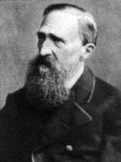
Paris: Editions du “Carnet,” 1902, 243 pages.
I assume this is a novel, or perhaps an abridgment of or excerpt from Caprea i Roma (1859).
A copy of L. De Broekere’s French translation is held at the
Bibliothèque nationale de France.
A microfiche copy of that same French translation is held at the
European Register of Microform and Digital Masters in Göttingen.
If you can copy it for me, I’ll give you a prize.
• Circa 1903.
Compagnie Liebig
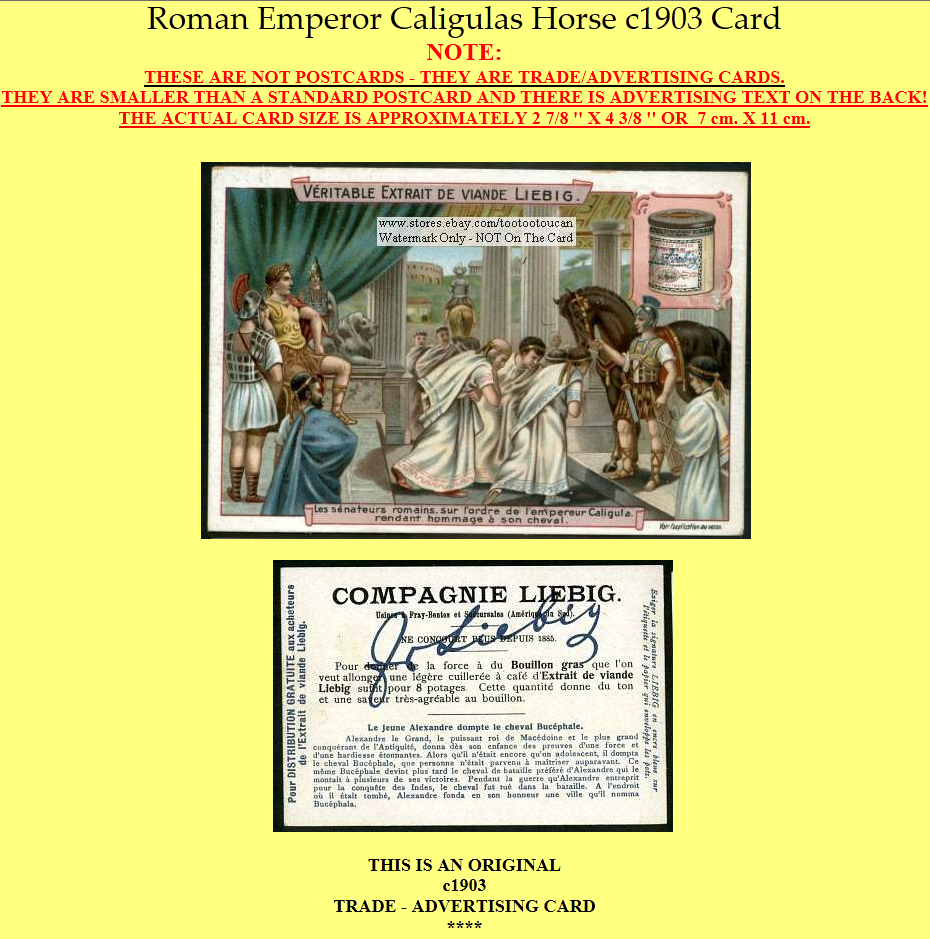
A trading card.
• 1905.
Caligula und Cäsonia: Schauspiel in 4 Aufz
by Friedrich Koch-Breuberg
Strassburg, 1905. A play.
Available at the
Bibliothèque nationale et universitaire. No information. Not a clue.
• 1906.
Caligula im Hafer: Humoristische Novelle aus dem Österreichischen Militärbeamtenleben
by Hugo Astl-Leonhard
Issue 496 of Kürschners Bücherschatz. (Hillger, 1906), 96 pages. No information. Not a clue.
• 1906.
Caligula, drama i fem akter
by Isted Møller

When you click on the link above, look for the button on the top-right corner of the screen, the one that looks like a gear. That’s the button you need to download the book to your computer.
• 1909.
by Mariano Vittori
G.B. Parvia e Comp., 1909. Does anybody know anything about this playwright?
If you know, please write to me. Thanks! Here’s a review from
Rivista teatrale italiana: pubblicazione bimestriale di letteratura, arte, storia e critica teatrale, anno 9, vol 14, fasc 1, January–February 1910:
• 1910.
Calígula: Drama en Cinco Actos
by Samuél Fernández Montalva
• 1911.
Caligula’s Picnic
by Maurice Baring
Included in a collection entitled
Diminutive Dramas (Boston and New York: Houghton Mifflin Company, 1911), pp 98–107.
• 26 April 1914.
Unto Cæsar
(tagline: IMPERIAL ROME IN THE DAYS OF THE MAD EMPEROR CALIGULA)
by Baroness Emma Maedalena Rosalia Maria Josefa Barbara “Emmuska” Orczy
 The New York Times Book Review, Sunday, 26 April 1914, p. 216. |
|
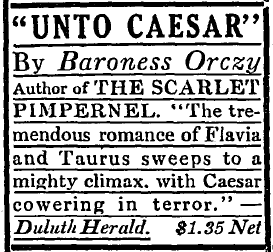 The New York Times Book Review, Sunday, 14 June 1914, p. 280. |
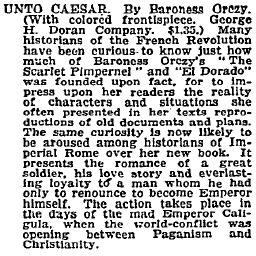 “One Hundred Books for Summer Reading,” The New York Times Book Review, Sunday, 14 June 1914, p. 276. |
• 1914.
[Caligula Dreaming]
by Morgan Heiskell
This is on Amazon, a listing entitled “1914 Print Caligula Bridge Dream Incense Military Bay Baiae Puzzuoli Trasyllus —
Original Halftone Print,”
and the description reads: “This is an original 1914 halftone print of Caligula dreaming the plans
for his strategic bridge between Baiae and Puzzoli that assured his accession to the Roman throne.
This beautiful image shows his dream manifesting from the incense he is burning
after falling asleep allowing his wine glass to fall at the foot of his chair.
This piece was illustrated by Heiskell, Morgan. Artist signature in print — bottom right of image.”
• 1916.
Caligola
I knew that Guazzoni did a movie version of Messalina in 1922,
which featured the character of Caligula in a secondary rôle,
but I did not know that he had done a Caligola a few years earlier.
See
Enrico Guazzoni and
Wikipedia.
Does anyone know if this film still exists?
If it does, where is it?
Click on Agrippina for a related film.
So much for scholars who say that silent movies did not use the Arial font.
Agrippina may look awfully silly to us. That’s because it is —
but there’s more to it than that.
The conventions were those of the stage of the time,
and this little movie is a valuable insight into the acting and staging techniques of the early 20th century,
which in turn were holdovers from the techniques of the 19th century.
In its own strange way, this movie really was helping to advance cinematographic art.
The sets, costumes, lighting, static compositions,
and tinting really are beautiful, aren’t they?
The framing from camera to camera is typically inconsistent,
a problem the Italians didn’t solve until the 1980s or perhaps even more recently.
Would someone like to compose some music for this?
As for Messalina, you can see
a sound reissue here
(dialogue added, and quite terribly),
minus the visual clarity, minus the tinting, minus the left side of the image,
overspeeded, severely abridged, and re-edited ,
but it’s better than nothing.
• 1917.
Kajus Cezar Kaligula,
dramat w czterech aktach
dramat w czterech aktach
• 1917.
La tragica fine di Caligola
a.k.a Dementia Caligulæ Imperatoris
a.k.a La tragica fine di Caligula Imperator
a.k.a Caligula
written by Jean Carrère, directed by Ugo Falena
This is a feature-length four-reeler.
At least two copies still exist, and maybe three.
An Italian posting from 19 June 2009
declares that this lost film had just recently been found,
but does not state where the found print was currently residing,
nor does it provide any specifics about the quality, completeness, condition, or format of the print.
It would seem probably to be at the Cineteca del Comune di Bologna,
though there’s no way to be certain judging from the web page’s roster.
The FIAF index states that a print is housed at the Cinémathèque Française.
Whether that’s the same print referred to in the Italian site,
or whether that’s a different print, is not clear.
Another print is a tinted/toned Dutch release with Dutch titles,
currently held at the EYE Film Instituut Nederland.
As far as I can determine, no preservation or restoration work has been done whatsoever,
and the prints may not have been viewed since 1917.
If anyone knows better, please contact me. Thanks!
Late-breaking news: The two known surviving prints were merged and the film was restored.
This little movie features the famous French/Polish actress Stacia Napierkowska,
about whom so little has been written.
So take a look
at this little article by Katherine Frances.
Is that fascinating ’er what?
Katherine has done us the favor of shooting over four pieces of ephemera that she found in her research:
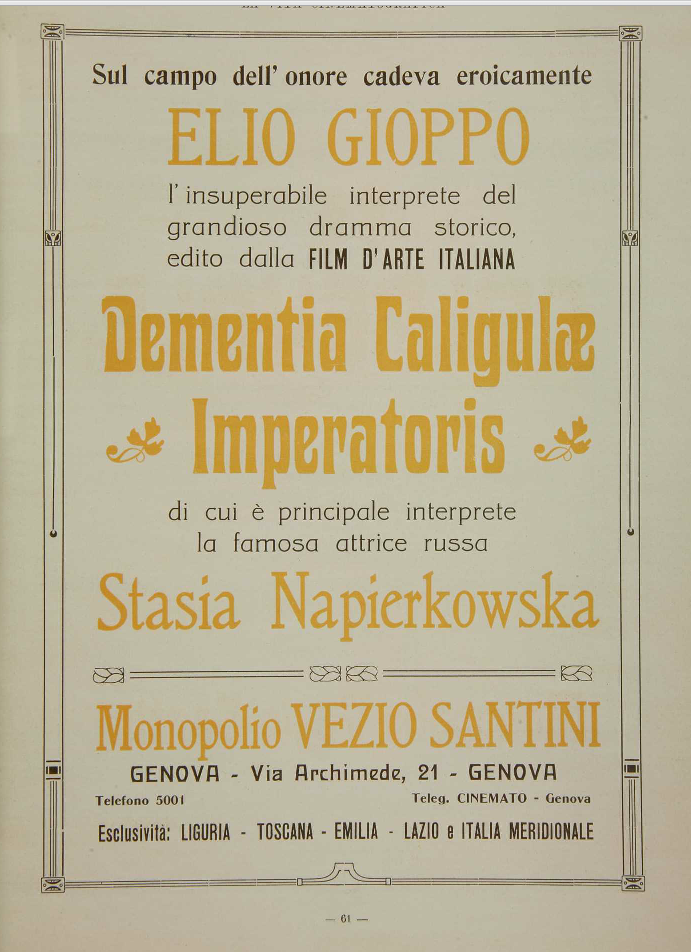
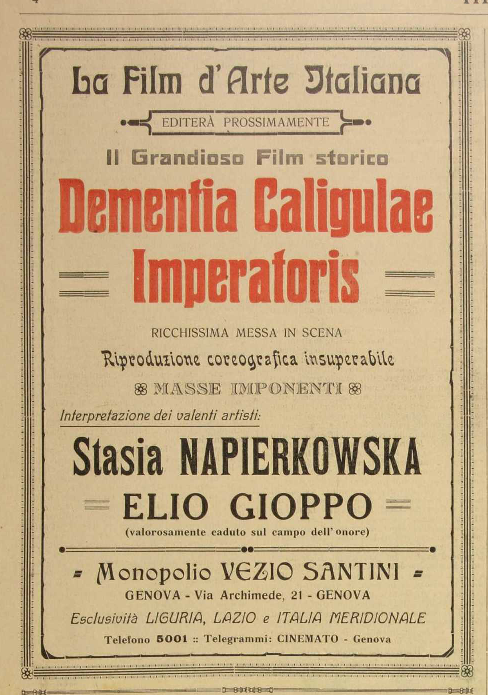
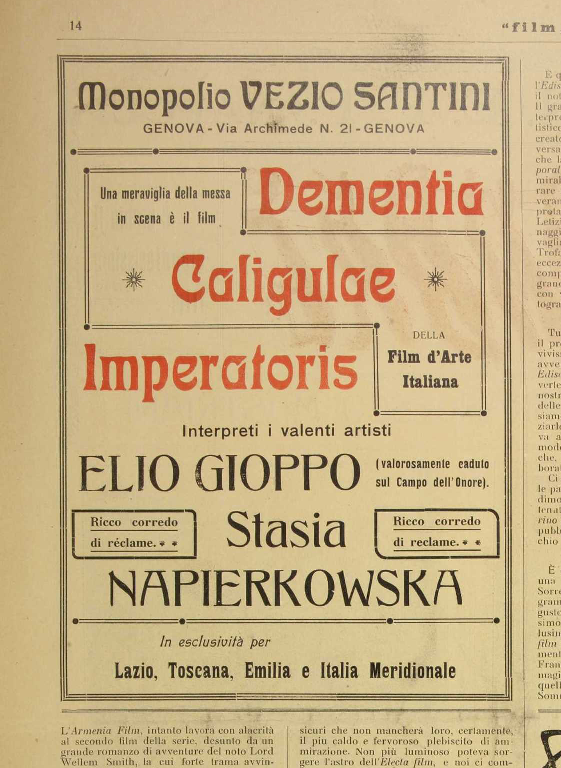

Zo, what can we learn about this obscure movie?
Well, Judith Harris seems to have seen it — maybe. Or maybe not.
She described it only in the vaguest terms in her book
Pompeii Awakened: A Story of Rediscovery (London: I.B. Tauris & Co Ltd, 2007), pp 211–212:
Another little tidbit comes from
Henri Bousquet and Vittorio Martinelli’s online filmography of Stasià Napierkowska (1891–1945),
which contradicts some other sources.
Bousquet and Martinelli confirm the above report that the original title was simply
La tragica fine di Caligola (with the Italian spelling of the name)
and further that it was also released with a strictly Latin title, Dementia Caligulæ Imperatoris,
which may explain other records that seem to combine both titles, mixing Italian and Latin.
Its title in France and the Netherlands was simply Caligula.
They also give the film-stock credit as Pathécolor
,
implying that at least some original prints were
stenciled. Beautiful process, isn’t it?
(Here’s a rival stenciling method, called Cinemacoloris:
Kiriki.)
Bousquet and Martinelli confirm the original length was 1,265m, which equals about 4,150',
meaning that the reels were all packed to the brim.
All right. Unlike many film scholars, I shall not unreasonably assume too much knowledge on the part of the reader.
With the proviso that there are occasional exceptions to every rule, these were the general rules, and so here’s what 4,150' means.
As far as I know, in Italy most projectors in 1917 were still hand-cranked ,
which would mean that, because of mechanical limitations, the speed could only have been about 60'/minute (16 frames/second).
Many film scholars will want to burn me at the stake for saying that, but it’s true.
Try running a hand-cranked projector, and you’ll instantly discover that at less than about 15fps the fire shutter drops,
and at above about 17fps the projector wobbles so violently that there’s risk of knocking it over.
And believe me, you don’t want to run the risk of knocking over an expensive, large, heavy, delicate projector,
especially when its light is created by an intense flame and when the machine is filled with highly inflammable film.
That would just ruin your whole darn day.
The problem is further complicated by having to use your left hand incessantly to feed the low-intensity carbon rods,
which is an exacting process and it ain’t easy.
(Yes, I’ve had to do that on occasion when carbon-drive motors fried. No, I never want to do that again.)
It was simply impossible to run a film above 17fps, and even keeping up at 16fps was a major physical effort.
Projectionists really deserved every penny they earned back in them thar days, and then some.
In the US by 1914 or thereabouts many projectors were being shipped from the factories
with optional motors and variable-speed pulleys to drive the film,
and optional pairs of motors to drive the carbon rods.
That’s when the speed started increasing to as much as 70'/minute or, in extreme cases, even 80'/minute,
but such practices were frowned upon by professionals.
It was not until late 1921, with the introduction of high-intensity rotating-positive carbon-arc lamp houses,
that the flicker became intolerable at 60'/minute.
I doubt that Europe had access to such technology in 1921/1922. I don’t think Europe got it until a few years later.
With the new lamphouses, projection speeds needed to be increased to a minimum of 65'/minute.
Cinemas with the new gigantic screens needed even more light and installed
two-wing rather than three-wing shutters,
and with that arrangement, flicker was intolerable at any speed lower than 82.5'/minute.
That’s when the modern speed of 90'/minute (24fps) became quite popular.
Why, I’m not quite sure, because the ASC and SMPE recommended
shooting films at 60'/minute and projecting at 80'/minute as a universal standard.
That’s not quite the way it worked out.
Downtown première movie palaces generally projected at 80'/minute unless instructed otherwise,
and yet and more and more frequently they were being instructed otherwise,
as more and more movies were being issued with instructions to be projected at “11 minutes for 1,000 feet,”
which equals 90'/minute or 24fps, give or take the odd microsecond here and there.
In Europe, though, the old standard of 60'/minute (16fps) for silent movies held forth well into the 1920s.
So in all likelihood this film needs to be shown at 60'/minute, which at 4,150 feet would equal about 69 minutes.
Complicating the issue is a web site called DVD toile
which provides uncited information; specifically, it reveals that the film’s original Pathé release number was 7943,
and it posts the official length as 1,385m (4,544'), which at 60'/min would be 76 minutes.
A 4,544' movie packed onto a mere four reels would spill film.
|
(If I ever hear that stupid Warner-Bros.-investigates-projection-practice-to-establish-Vitaphone-taking-speed
story again I’ll go on a killing spree.
The true story is that the modern speed was set by the limitations of early optical sound,
not by |
Bousquet and Martinelli also do us the favor of reproducing a Dutch trade advertisement:
So it is a “Legend from the Time of Christian Persecution.”
If we run those part titles through Google Translator, this is what we get:
Part 1: Caligula’s Insanity.
Part 2: Arius’s Revenge.
Part 3: The Orgies.
Part 4: The End of a Tyrant.
Part 2: Arius’s Revenge.
Part 3: The Orgies.
Part 4: The End of a Tyrant.
• 1925.
by Eugene O’Neill
Was not performed until 1928, when it premièred at the Pasadena Community Playhouse.
Has almost never been performed since.
Caligula is an important character in the story.
• 1934.
I, Claudius
by Robert Graves
London: Arthur Barker, 1934. A novel.
This is the big one. This is the novel that made Caligula and Claudius and the rest of that gang household names.
• 1936.
Caligula
produced by by Alexander Korda
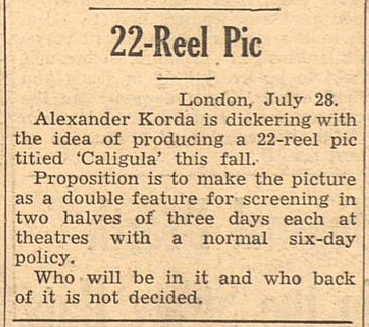
Variety vol. 123 no. 7, Wednesday, 29 July 1936, p. 1
Okay all you cinema historians with Ph.D.’s, you never knew about this before, did you?
22 reels, assuming each reel would run between 8 and 11 minutes on average,
would total between about three hours at the low end and three and a half hours at the high end.
This project was abandoned and quickly replaced by the epic below.
My guess is that it probably cost less and would take less time to adapt a novel to a screenplay
than it would to write a new screenplay from scratch.
I would imagine, also, that upon learning of the Caligula project,
publisher Arthur Barker pushed Graves’s book upon Korda and made a convincing case.
• 1936.
The Fool of Rome (a.k.a. I, Claudius)
by Robert Graves, directed by Josef von Sternberg
produced by Alexander Korda
This movie adaptation of I, Claudius was never completed.
See Archives Hub.
Claudius: Charles Laughton. Messalina: Merle Oberon. Livia: Flora Robson. Caligula: Emlyn Williams.
• 25 December 1938.
by Norman Corwin

Mount Vernon NY: Peter Pauper Press, 1940.
First-edition limited printing of 150 copies for friends of Peter and Edna Beilenson.
A verse play aired on CBS Radio. Caligula is an important character in the story.
The
1940 performance is available on CD.
Click here, scroll down, and listen to the 1942 performance.
The
1945 performance, directed by and featuring Orson Welles,
is here.
This was later done on television.
• 1942.
The Robe
by Lloyd C. Douglas
New York: Houghton Mifflin, 1942. A novel. Caligula is an important character.
• 1943.
Calígula: Biografía Humorística
by Fidélio Trimalción [pseudonym for Cecílio Benítez de Castro]
Barcelona: Argos, 1943. No clue.
• 18 December 1945 at the Théâtre-Hébertot in Paris.
Caligula
by Albert Camus
Albert Camus, Caligula. Opened as four-act.
The
earlier three-act draft from 1941 has also been staged.
Justin O’Brien’s English adaptation is two acts.
The full four-act play was translated into English and staged by Harald Bromley.
See Wikipedia.
• 1953.
Bubi Caligula;
Operette in einem Vorspiel und 2 Akten
Operette in einem Vorspiel und 2 Akten
Vienna: A-Tempo-Verlag, 1953, 167 pages. Would you believe an operetta?
At SUNY Buffalo, Harvard, and The British Library—St Pancras..
• 1953.
The Robe
by Gina Kaus, Albert Maltz, and Philip Dunne; directed by Henry Koster
The first Cinemascope movie, 1:2.66, full aperture, four-track on separated mag tracks synched by selsyns.
Also filmed and released in Academy 1:1.375 monaural. Caligula is an important character.
• 1954.
Demetrius and the Gladiators
by Philip Dunne; directed by Delmer Daves
The sequel to The Robe. Caligula is an important character.
by John Updike
Originally published in The Opinion vol. 68 no. 13 (27 June 1958).
Included in Collected Poems 1953–1993 (New York: Knopf: Distributed by Random House, 1993).
• 1958.
I, Claudius
Adapted by Robert Graves and Bridget Boland
This was supposed to have been a movie.
See Archives Hub.
Alec Guinness was considered for the rôle of Claudius. Never produced.
• 26 October 1958 at the York Playhouse, New York City.
by Maxwell Anderson

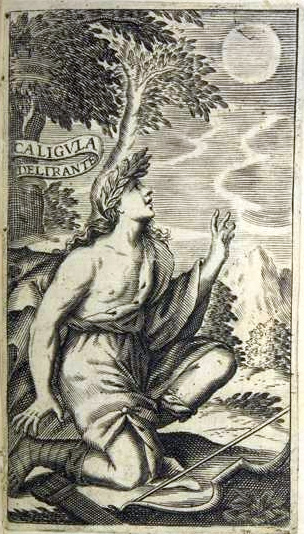
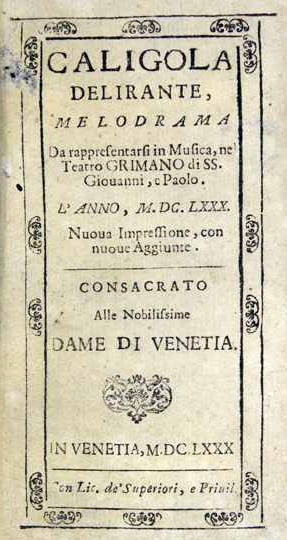

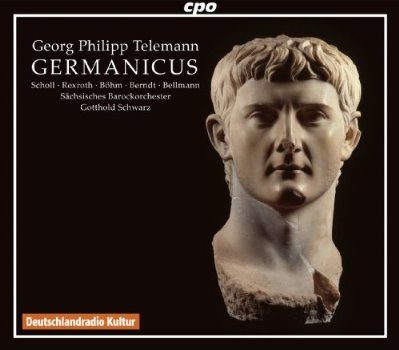
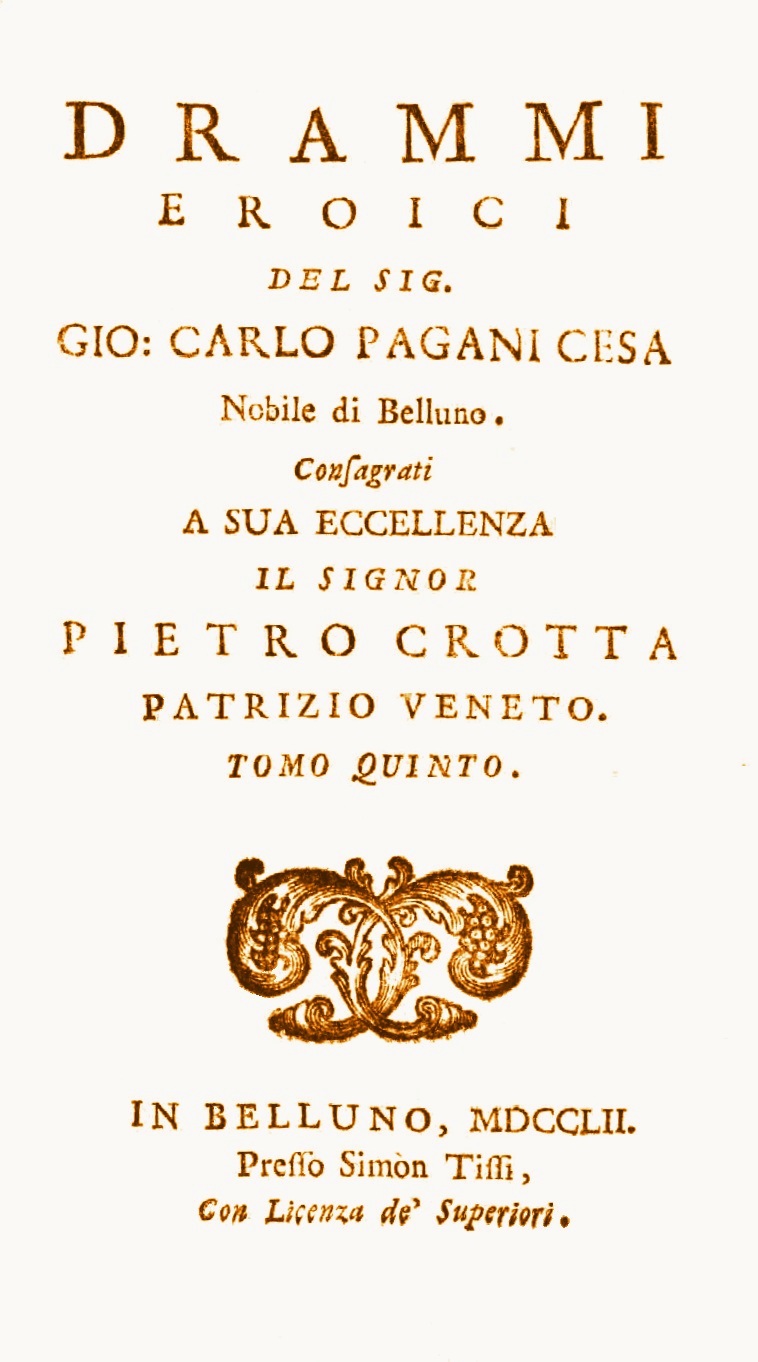

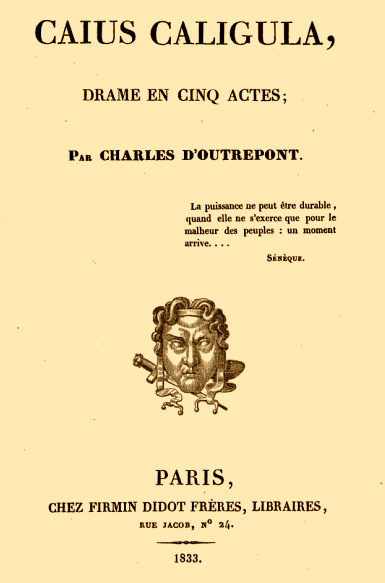
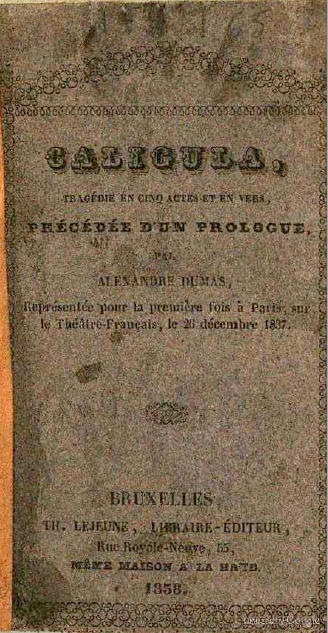



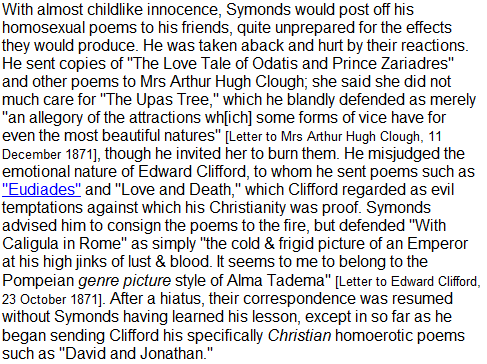
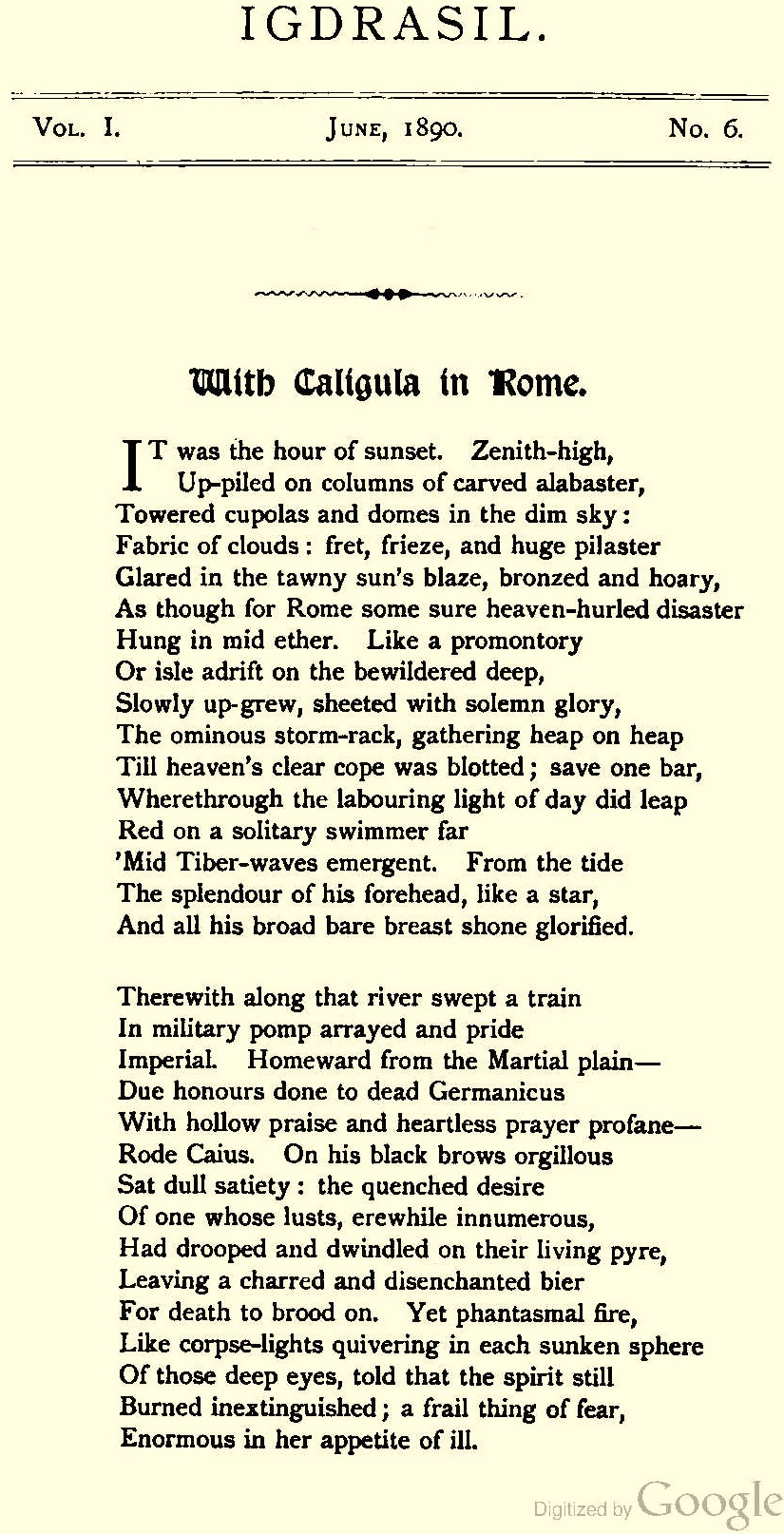
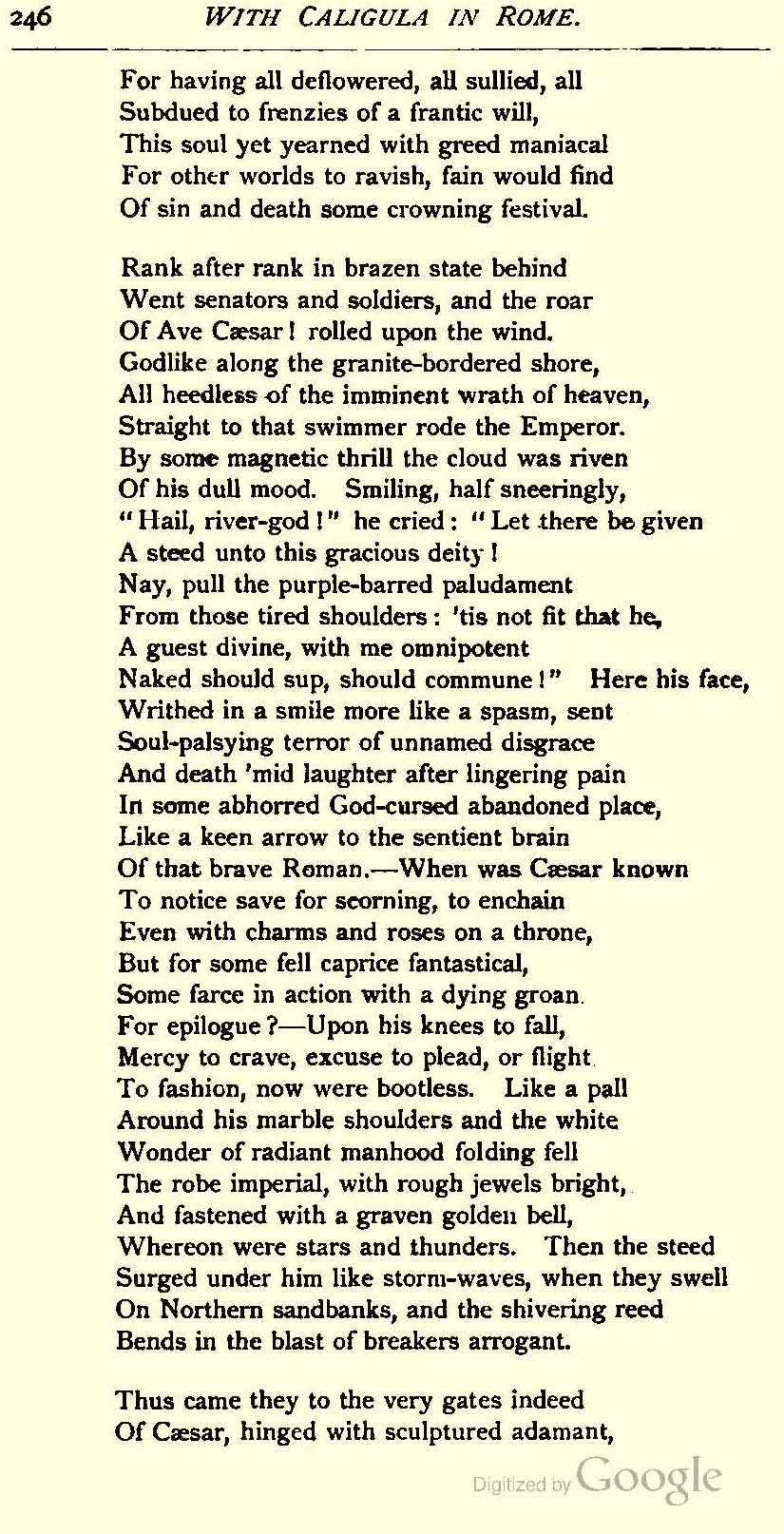

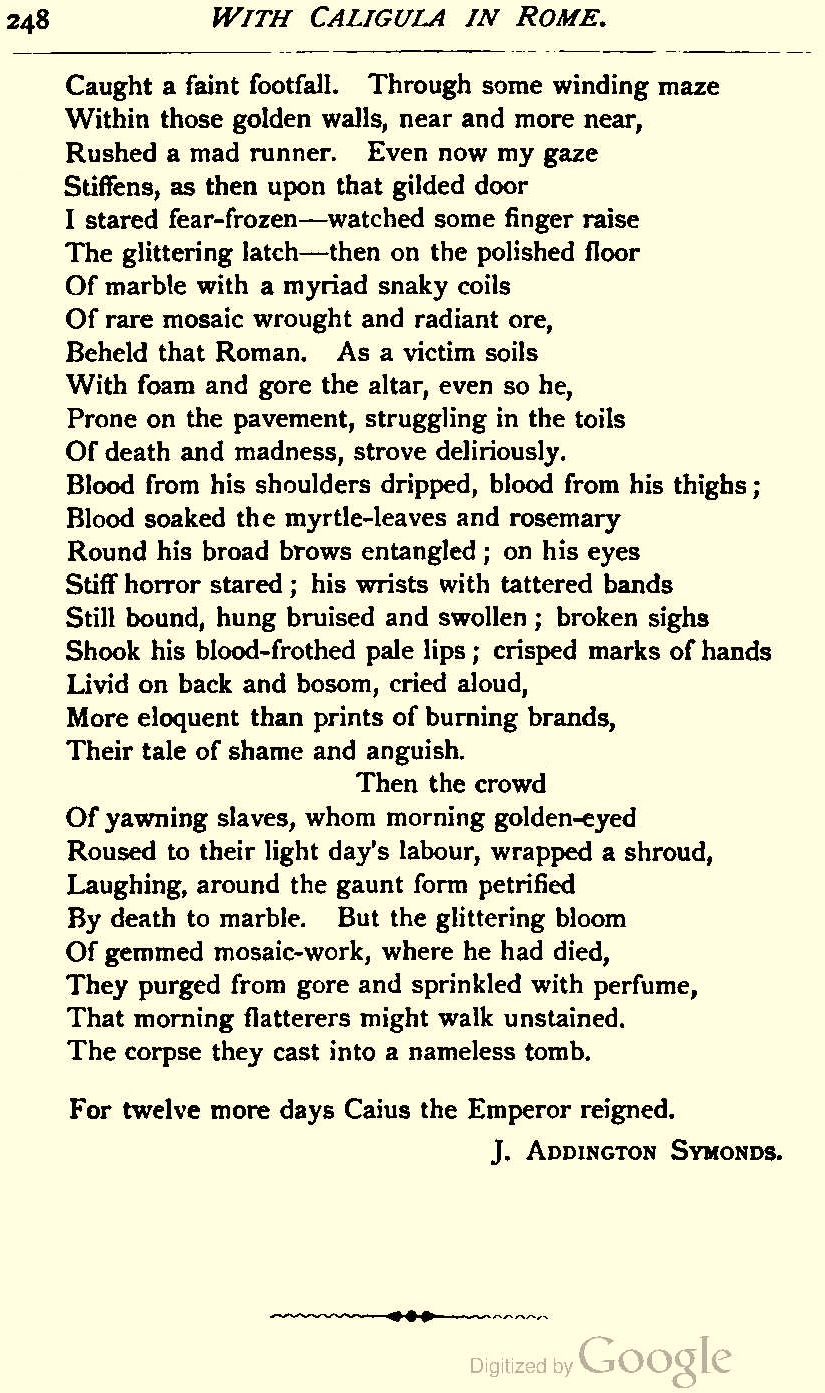


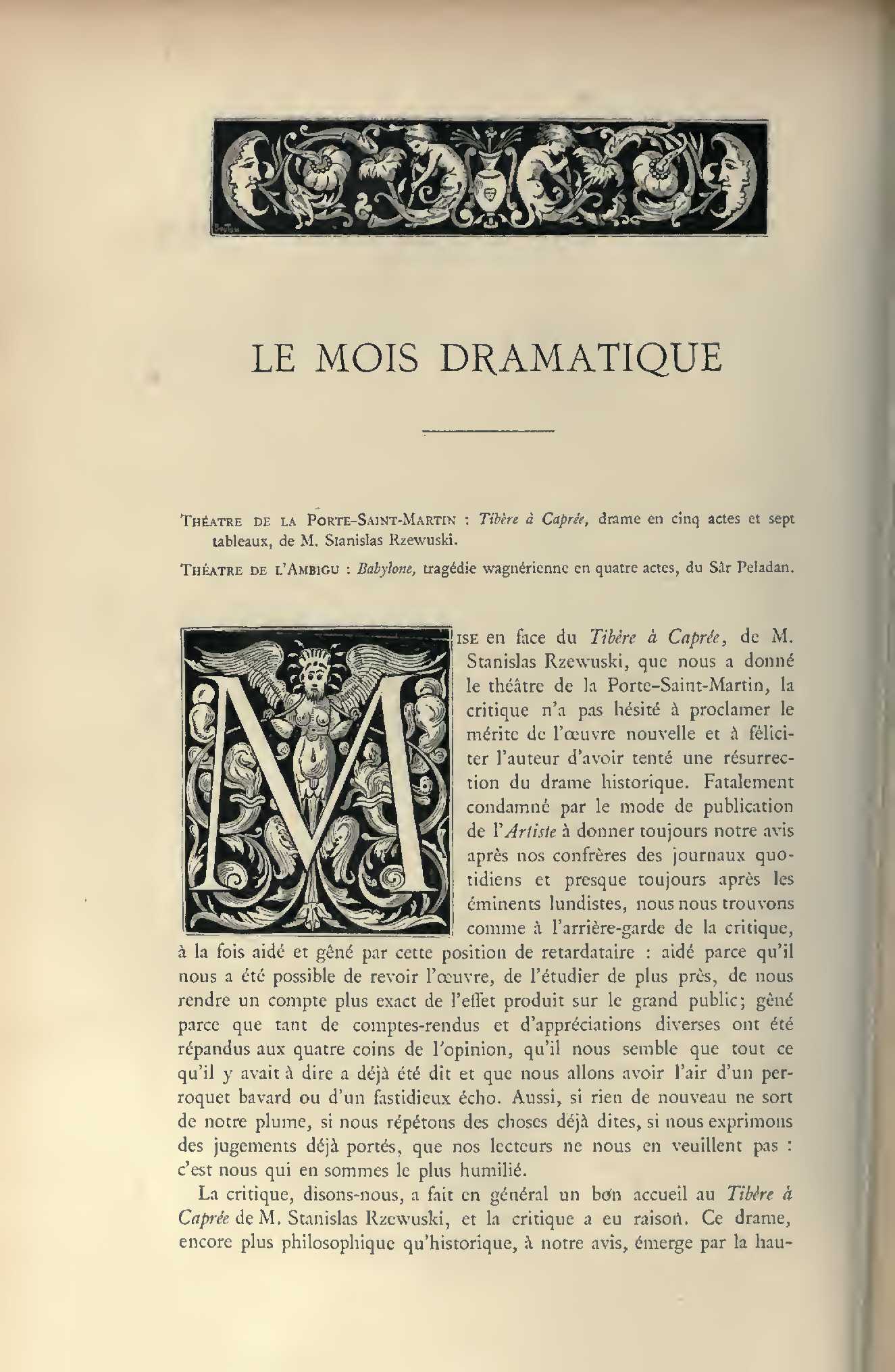

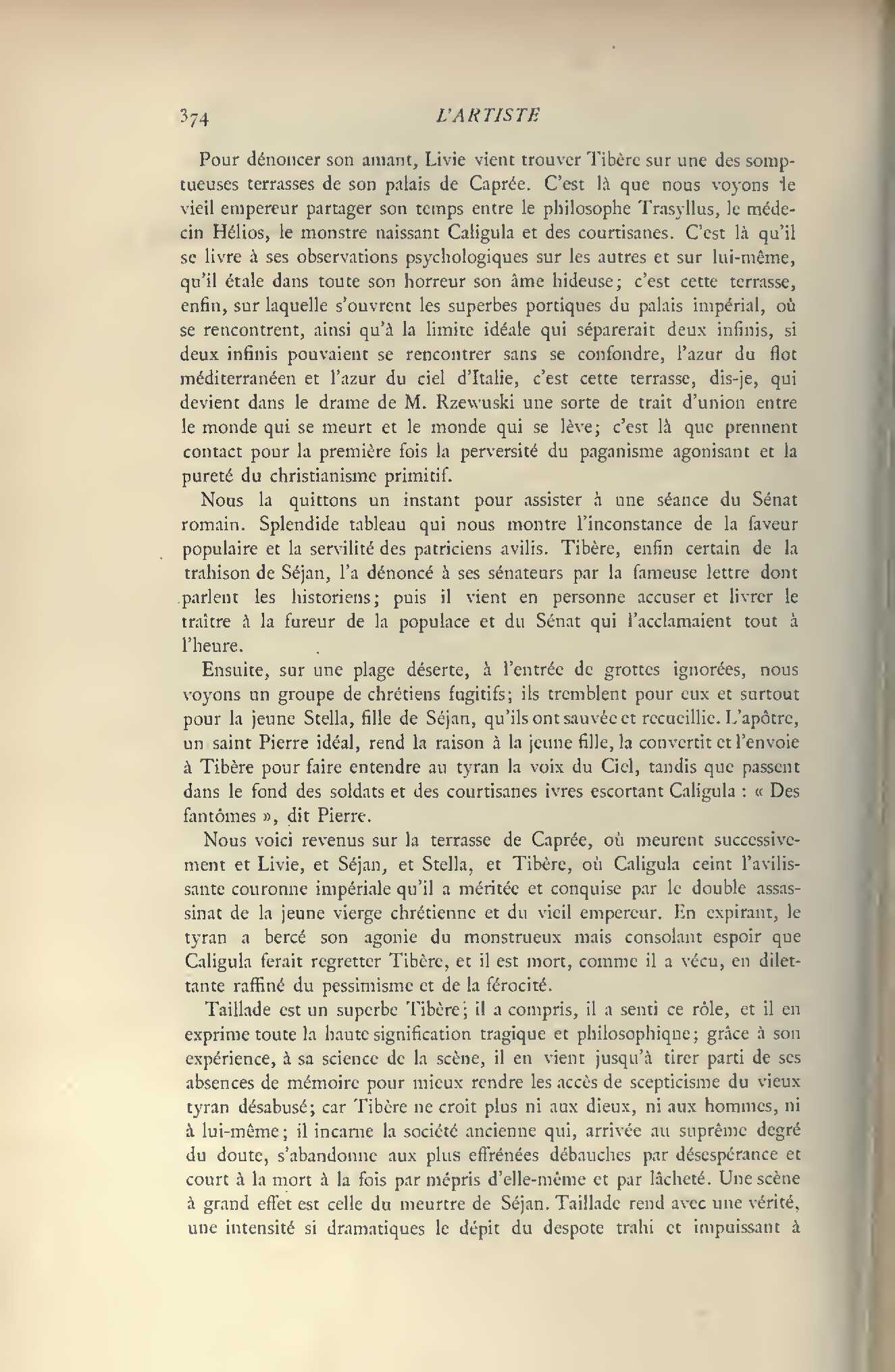
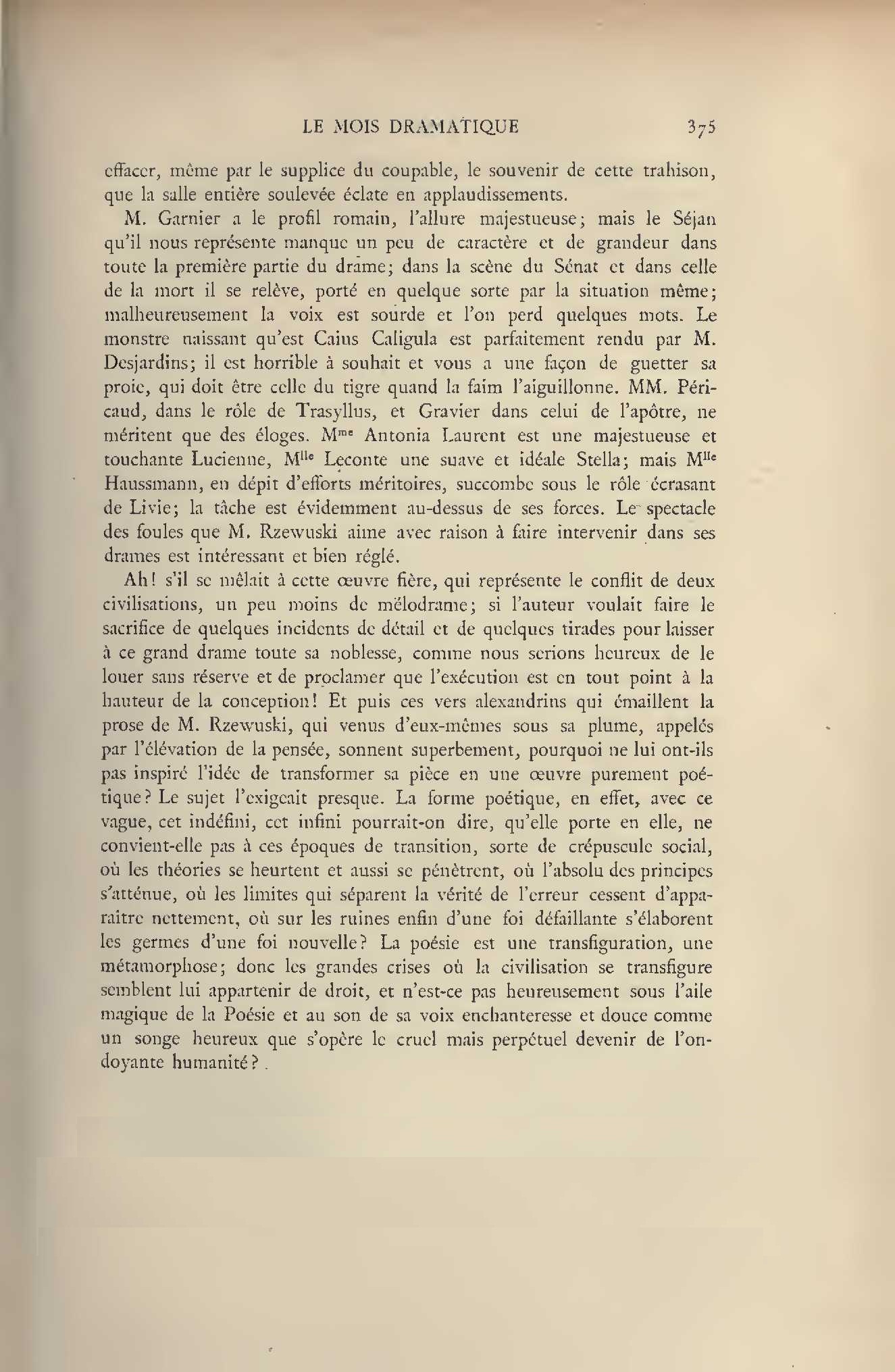
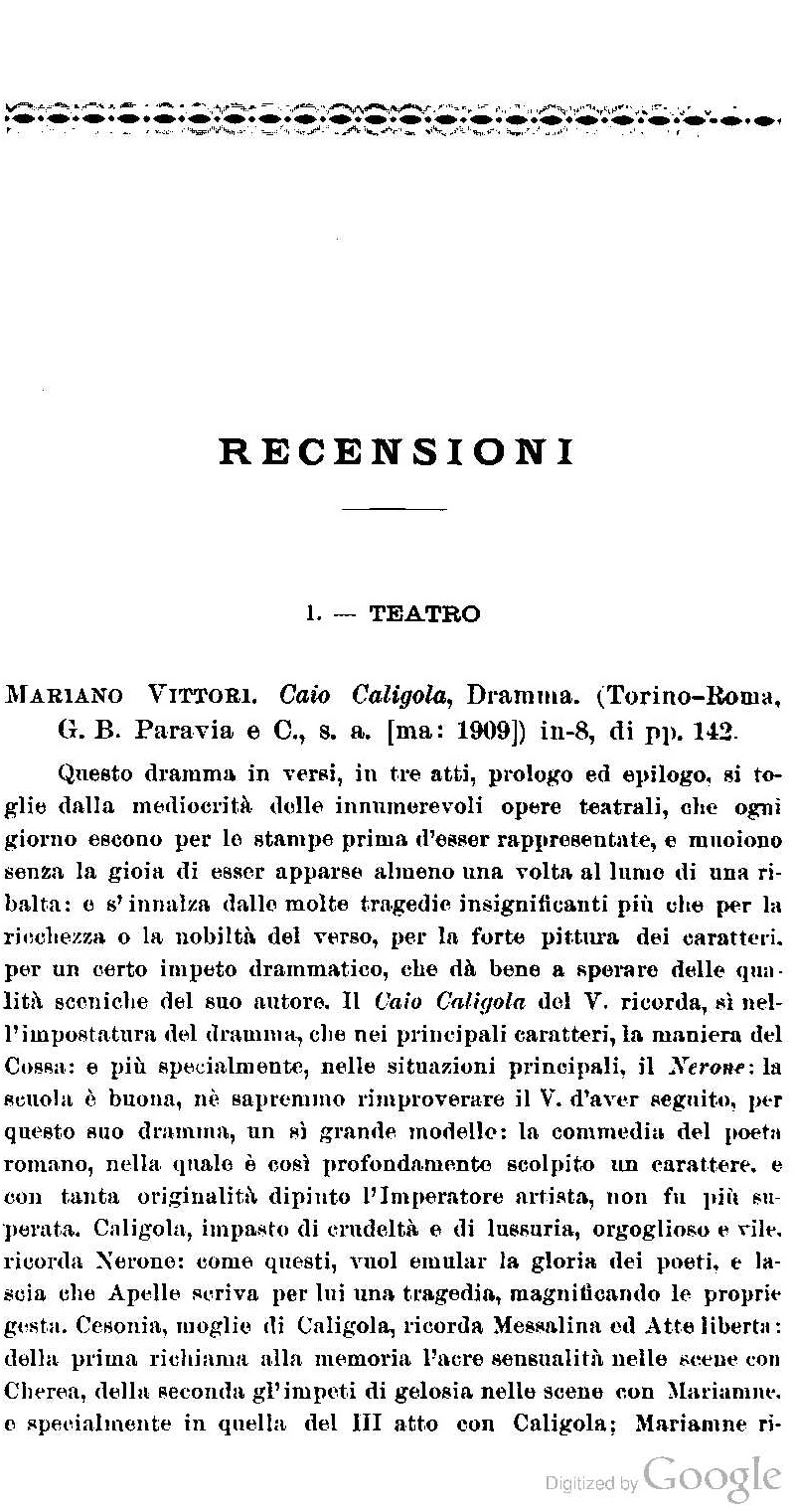
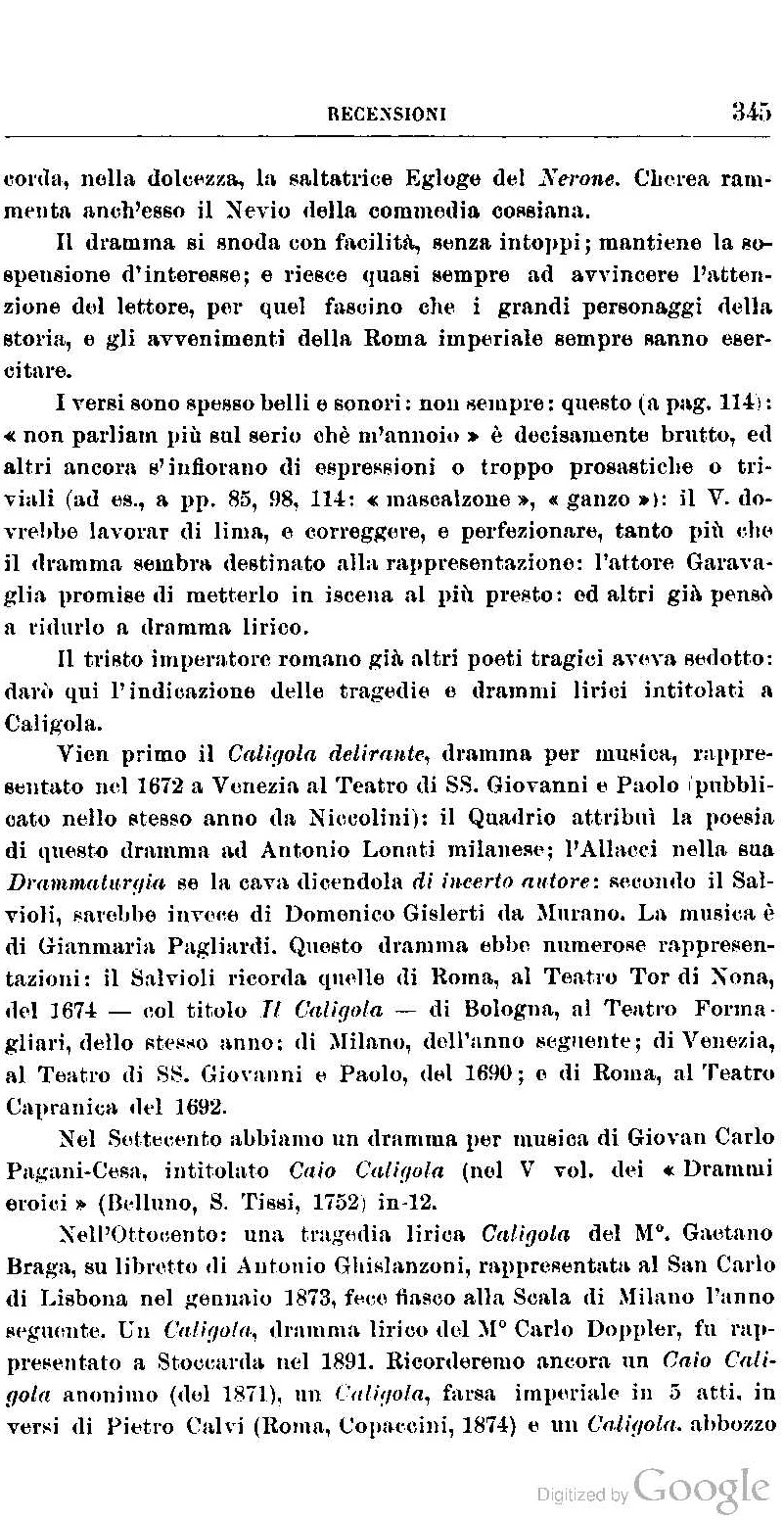
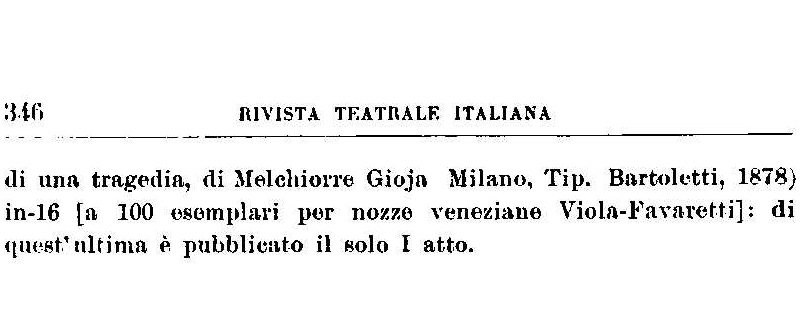
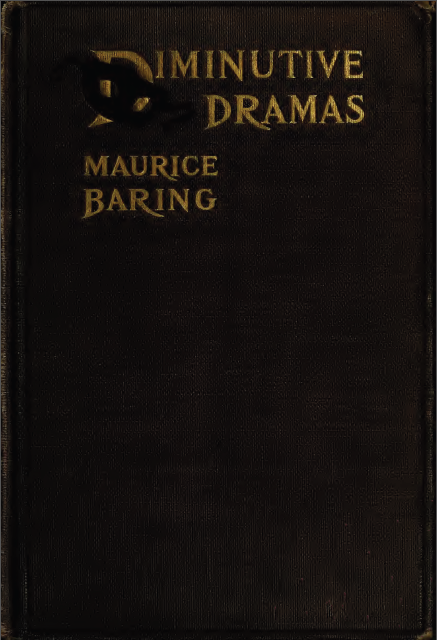
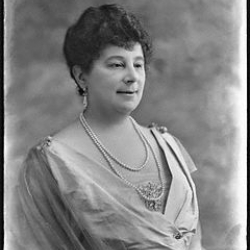
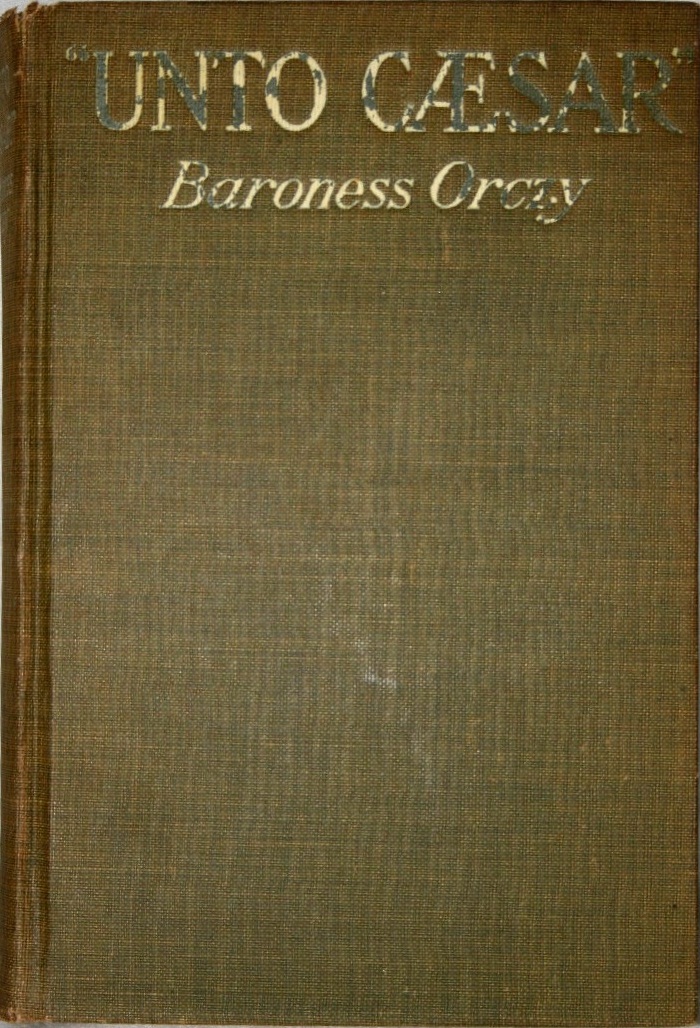


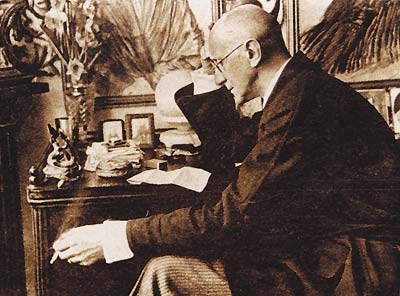

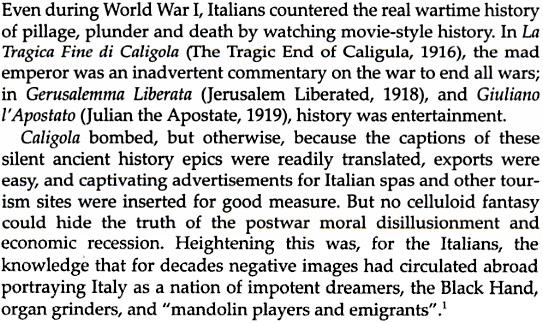
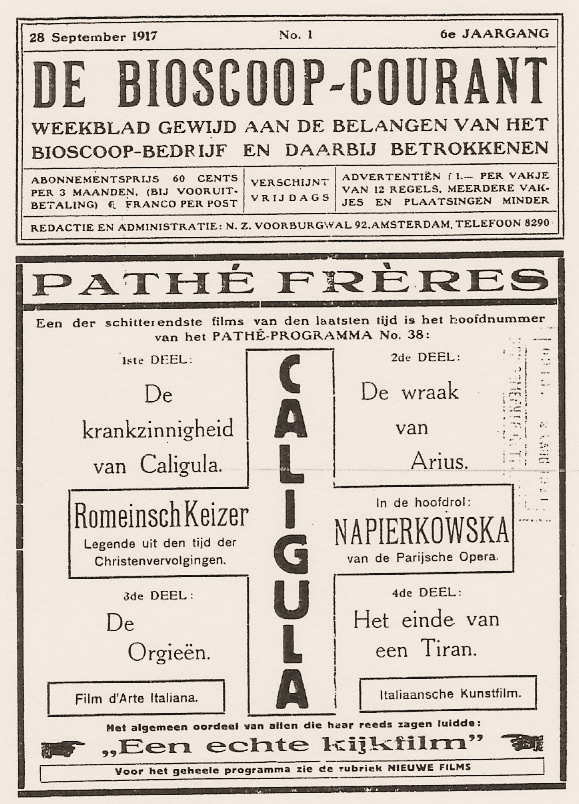
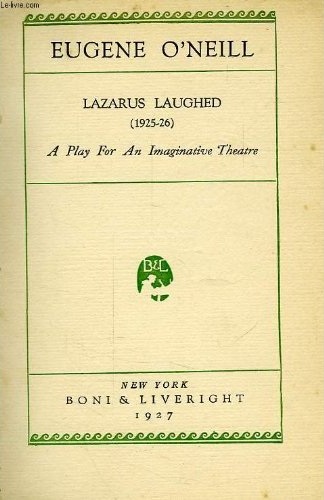
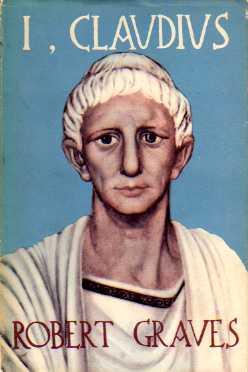
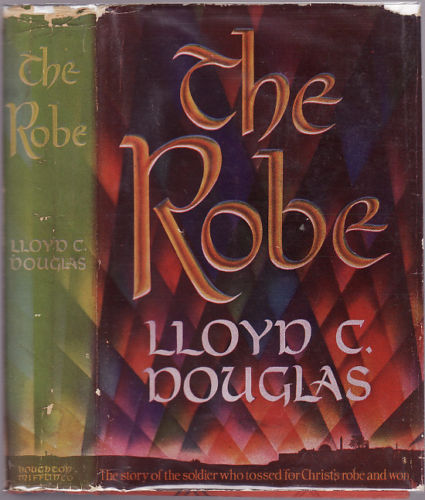
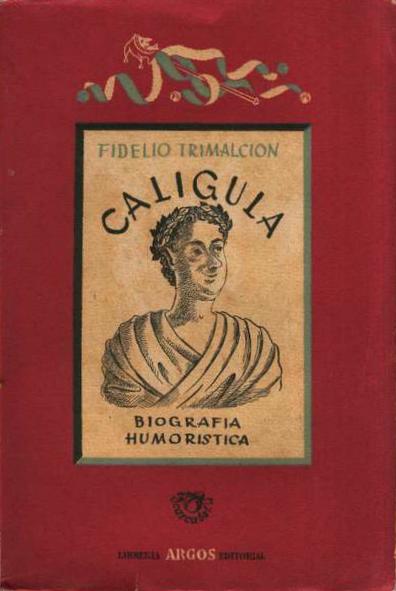
.jpg)
